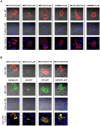A newly uncovered group of distantly related lysine methyltransferases preferentially interact with molecular chaperones to regulate their activity
- PMID: 23349634
- PMCID: PMC3547847
- DOI: 10.1371/journal.pgen.1003210
A newly uncovered group of distantly related lysine methyltransferases preferentially interact with molecular chaperones to regulate their activity
Abstract
Methylation is a post-translational modification that can affect numerous features of proteins, notably cellular localization, turnover, activity, and molecular interactions. Recent genome-wide analyses have considerably extended the list of human genes encoding putative methyltransferases. Studies on protein methyltransferases have revealed that the regulatory function of methylation is not limited to epigenetics, with many non-histone substrates now being discovered. We present here our findings on a novel family of distantly related putative methyltransferases. Affinity purification coupled to mass spectrometry shows a marked preference for these proteins to associate with various chaperones. Based on the spectral data, we were able to identify methylation sites in substrates, notably trimethylation of K135 of KIN/Kin17, K561 of HSPA8/Hsc70 as well as corresponding lysine residues in other Hsp70 isoforms, and K315 of VCP/p97. All modification sites were subsequently confirmed in vitro. In the case of VCP, methylation by METTL21D was stimulated by the addition of the UBX cofactor ASPSCR1, which we show directly interacts with the methyltransferase. This stimulatory effect was lost when we used VCP mutants (R155H, R159G, and R191Q) known to cause Inclusion Body Myopathy with Paget's disease of bone and Fronto-temporal Dementia (IBMPFD) and/or familial Amyotrophic Lateral Sclerosis (ALS). Lysine 315 falls in proximity to the Walker B motif of VCP's first ATPase/D1 domain. Our results indicate that methylation of this site negatively impacts its ATPase activity. Overall, this report uncovers a new role for protein methylation as a regulatory pathway for molecular chaperones and defines a novel regulatory mechanism for the chaperone VCP, whose deregulation is causative of degenerative neuromuscular diseases.
Conflict of interest statement
The authors have declared that no competing interests exist.
Figures






Similar articles
-
The homozygote VCP(R¹⁵⁵H/R¹⁵⁵H) mouse model exhibits accelerated human VCP-associated disease pathology.PLoS One. 2012;7(9):e46308. doi: 10.1371/journal.pone.0046308. Epub 2012 Sep 28. PLoS One. 2012. PMID: 23029473 Free PMC article.
-
The heterozygous R155C VCP mutation: Toxic in humans! Harmless in mice?Biochem Biophys Res Commun. 2018 Sep 18;503(4):2770-2777. doi: 10.1016/j.bbrc.2018.08.038. Epub 2018 Aug 9. Biochem Biophys Res Commun. 2018. PMID: 30100055
-
IBMPFD Disease-Causing Mutant VCP/p97 Proteins Are Targets of Autophagic-Lysosomal Degradation.PLoS One. 2016 Oct 21;11(10):e0164864. doi: 10.1371/journal.pone.0164864. eCollection 2016. PLoS One. 2016. PMID: 27768726 Free PMC article.
-
Valosin-Containing Protein (VCP)/p97 Oligomerization.Subcell Biochem. 2024;104:485-501. doi: 10.1007/978-3-031-58843-3_18. Subcell Biochem. 2024. PMID: 38963497 Review.
-
The multiple faces of valosin-containing protein-associated diseases: inclusion body myopathy with Paget's disease of bone, frontotemporal dementia, and amyotrophic lateral sclerosis.J Mol Neurosci. 2011 Nov;45(3):522-31. doi: 10.1007/s12031-011-9627-y. Epub 2011 Sep 3. J Mol Neurosci. 2011. PMID: 21892620 Review.
Cited by
-
Emerging roles of lysine methylation on non-histone proteins.Cell Mol Life Sci. 2015 Nov;72(22):4257-72. doi: 10.1007/s00018-015-2001-4. Epub 2015 Jul 31. Cell Mol Life Sci. 2015. PMID: 26227335 Free PMC article. Review.
-
Selenium-based S-adenosylmethionine analog reveals the mammalian seven-beta-strand methyltransferase METTL10 to be an EF1A1 lysine methyltransferase.PLoS One. 2014 Aug 21;9(8):e105394. doi: 10.1371/journal.pone.0105394. eCollection 2014. PLoS One. 2014. PMID: 25144183 Free PMC article.
-
Uncovering the protein lysine and arginine methylation network in Arabidopsis chloroplasts.PLoS One. 2014 Apr 18;9(4):e95512. doi: 10.1371/journal.pone.0095512. eCollection 2014. PLoS One. 2014. PMID: 24748391 Free PMC article.
-
Histidine methylation of yeast ribosomal protein Rpl3p is required for proper 60S subunit assembly.Mol Cell Biol. 2014 Aug;34(15):2903-16. doi: 10.1128/MCB.01634-13. Epub 2014 May 27. Mol Cell Biol. 2014. PMID: 24865971 Free PMC article.
-
Lysine trimethylation regulates 78-kDa glucose-regulated protein proteostasis during endoplasmic reticulum stress.J Biol Chem. 2017 Nov 17;292(46):18878-18885. doi: 10.1074/jbc.M117.797084. Epub 2017 Sep 14. J Biol Chem. 2017. PMID: 28912266 Free PMC article.
References
-
- Martin JL, McMillan FM (2002) SAM (dependent) I AM: the S-adenosylmethionine-dependent methyltransferase fold. Curr Opin Struct Biol 12: 783–793. - PubMed
-
- Ishizawa T, Nozaki Y, Ueda T, Takeuchi N (2008) The human mitochondrial translation release factor HMRF1L is methylated in the GGQ motif by the methyltransferase HMPrmC. Biochem Biophys Res Commun 373: 99–103. - PubMed
-
- Klotz AV, Leary JA, Glazer AN (1986) Post-translational methylation of asparaginyl residues. Identification of beta-71 gamma-N-methylasparagine in allophycocyanin. J Biol Chem 261: 15891–15894. - PubMed
Publication types
MeSH terms
Substances
Grants and funding
LinkOut - more resources
Full Text Sources
Other Literature Sources
Molecular Biology Databases
Miscellaneous

